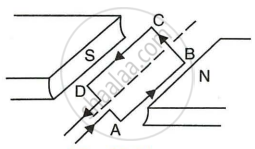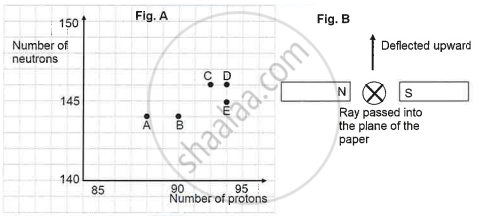Advertisements
Advertisements
प्रश्न
Name and state the rule to determine the direction of magnetic field around a straight current-carrying conductor.
उत्तर
Maxwell’s right-hand thumb rule is used to determine the direction of magnetic field around a straight current-carrying conductor.
According to this rule, if we grasp a current-carrying wire in our right hand so that our thumb points in the direction of the current, the direction in which our fingers encircle the wire will give the direction of magnetic field lines around the wire.
When thumb points upwards, the curled fingers are anticlockwise. So, the direction of magnetic field lines is anticlockwise.
When thumb points downwards, the curled fingers are clockwise. So, the direction of magnetic field lines is clockwise.
APPEARS IN
संबंधित प्रश्न
Which of the following correctly describes the magnetic field near a long straight wire?
Observe the following figure:

If the current in the coil A is changed, will some current be induced in the coil B? Explain.
What concealed do you get from the observation that a current-carrying wire deflects a compass needle placed near it?
What type of core should be put inside a current-carrying solenoid to make an electromagnet?
What happens when a current-carrying conductor is placed in a magnetic field?
Two coils A and B of insulated wire are kept close to each other. Coil A is connected to a galvanometer while coil B is connected to a battery through a key. What would happen if:
the current is stopped by removing the plug from the key?
Explain your answer mentioning the name of the phenomenon involved.
A coil ABCD mounted on an axle is placed between the poles N and S of a permanent magnet as shown in Figure.

- In which direction will the coil begin to rotate when current is passed through the coil in direction ABCD by connecting a battery at the ends A and D of the coil?
- Why is a commutator necessary for continuous rotation of the coil?
- Complete the diagram with commutator, etc. for the flow of current in the coil?
The strength of magnetic field around a current-carrying conductor is ____________.
A copper conductor is placed over two stretched copper wires whose ends ate connected to a D.C. supply as shown in the diagram.
- What should be the magnetic poles at the points A and B lying on either side of the conductor to experience the force in the upward direction?
- Name the law used to find these polarities.

|
The graph (fig A) illustrates the correlation between the number of protons (x-axis) and the number of neutrons (y-axis) for elements A, B, C, D, and E in the periodic table. These elements are denoted by the letters rather than their conventional symbols. When the element C, depicted in the graph, undergoes radioactive decay, it releases radioactive rays. When these rays are directed into the plane of the paper in the presence of a magnetic field, as indicated in the fig B, they experience deflection, causing them to move upwards.
|
Name the law used to identify the radioactive radiation emitted by the element.

